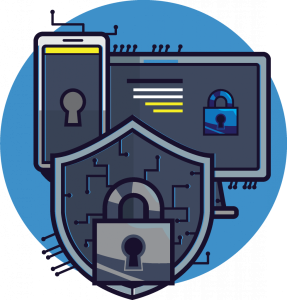Comprehensive network security
4. MALWARE AND ANTIVIRUS
4.3. The Most Common Malware Types
Among the many different types of malwares, it is possible to identify the following most common forms:
· Adware – Already mentioned before, adware is an unwanted software developed to display advertisements on user’s screens, many times within a web browser. This form of malware uses an underhanded method to disguise itself as legitimate or overlapped on another program to hide itself and trick the user for its installation.
· Spyware – By its mean, spyware focuses its action on secretly observing the computer or user’s actions and activities without permission, reporting it to the malware’s developer.
· Virus – Virus can also be seen as a malware since it consists also of an infection that attaches to another program and, when executed, replicates itself by modifying other computer programs and infecting them with its own bits of code. Its behaviour is once again similar to a virus that infects human, where it attacks the body cells to inject its genetic material and replicate itself in the body.
· Worms – Worms are similar to virus and just like these, worms also self-replicate by modifying other computer programs to make copies of itself. The difference between a virus and a worm is that worms can spread across systems on their own, while viruses need some sort of action from the user, to be able to start its infection process.
· Trojan – Also known as trojan horse, this malware is seen as one of the most dangerous types, because it usually represents itself as something trustful when, in fact, it is not. Once it reaches the system, the attackers behind the trojan gain unauthorized access to the affected computer. From there, trojan to perform the most various actions, such as, for instance, steal financial information or even install other forms of malware.
· Ransomware – Like mentioned before, ransomware is a form of malware that can lock the user out of the device, encrypting all data and files and forcing the user to pay a certain amount of money to regain access. Ransomware is one of the most used malware forms because it brings a direct profit source, usually in a hard-to-trace payment such as cryptocurrency. Unfortunately, the code behind ransomware is easy to obtain through online criminal marketplaces and defending the systems against it is a very difficult task.
· Rootkit – This malware type provides the attacker with administrator rights on the infected system or network, also known as “root” on may Unix systems. Similar to other types, rootkit is also designed to be hidden and imperceptible from the user, other software on the system, and the operating system itself.
· Keylogger – A keylogger is a malware capable of recording all the user’s keystrokes on the keyboard, gathering information, and sending it to the attacker. Usually, these attackers seek for authentication credentials, including usernames, passwords, credit card details, between others.
· Malicious Cryptomining – Also known as drive-by mining or cryptojacking, this form of malware is usually installed by a trojan, allowing the attacker to use the computer to mine cryptocurrency like Bitcoins or Monero. Here, instead of letting the user to cash the collected coins, attackers send them to their own account.
· Exploits – This form of malware takes advantages of bugs and other existing vulnerabilities, of a system or network, to give some sort of access to the attacker. While there, the attacker will be capable to steal or access data or even drop or inject code such as another form of malware. A zero-day exploit refers to a software vulnerability for which there is currently no available defense or fix.
· Scareware – In this case, cybercriminals scare users, making them think that their computers or mobile devices have become infected, to convince them to purchase a fake application. In a typical scareware scam, there is possible to see an alarming message while browsing the Web that says “Warning: Your computer is infected!” or “You have a virus!” Cybercriminals use these programs and unethical advertising practices to frighten users into purchasing rogue applications.
· Fileless Malware – This form of malware registry attacks leaves no malware files to be scanned neither malicious process to be detected. It does not rely on files, and, by this, leaving no footprint, which makes it a challenge to detect and remove. Such malware uses legitimate programs to infect the system or network.
